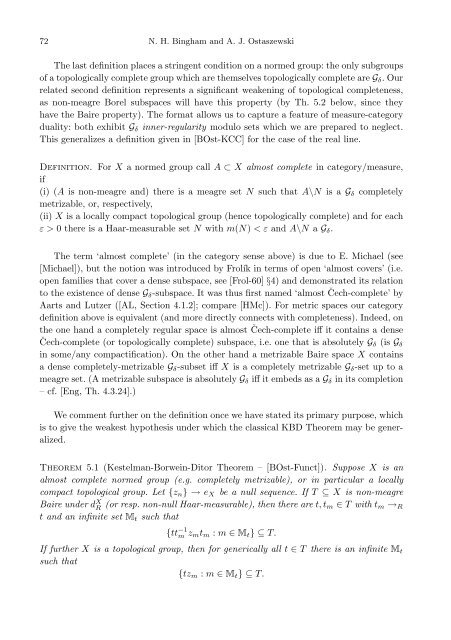Normed versus topological groups: Dichotomy and duality
Normed versus topological groups: Dichotomy and duality
Normed versus topological groups: Dichotomy and duality
You also want an ePaper? Increase the reach of your titles
YUMPU automatically turns print PDFs into web optimized ePapers that Google loves.
72 N. H. Bingham <strong>and</strong> A. J. OstaszewskiThe last definition places a stringent condition on a normed group: the only sub<strong>groups</strong>of a <strong>topological</strong>ly complete group which are themselves <strong>topological</strong>ly complete are G δ . Ourrelated second definition represents a significant weakening of <strong>topological</strong> completeness,as non-meagre Borel subspaces will have this property (by Th. 5.2 below, since theyhave the Baire property). The format allows us to capture a feature of measure-category<strong>duality</strong>: both exhibit G δ inner-regularity modulo sets which we are prepared to neglect.This generalizes a definition given in [BOst-KCC] for the case of the real line.Definition. For X a normed group call A ⊂ X almost complete in category/measure,if(i) (A is non-meagre <strong>and</strong>) there is a meagre set N such that A\N is a G δ completelymetrizable, or, respectively,(ii) X is a locally compact <strong>topological</strong> group (hence <strong>topological</strong>ly complete) <strong>and</strong> for eachε > 0 there is a Haar-measurable set N with m(N) < ε <strong>and</strong> A\N a G δ .The term ‘almost complete’ (in the category sense above) is due to E. Michael (see[Michael]), but the notion was introduced by Frolík in terms of open ‘almost covers’ (i.e.open families that cover a dense subspace, see [Frol-60] §4) <strong>and</strong> demonstrated its relationto the existence of dense G δ -subspace. It was thus first named ‘almost Čech-complete’ byAarts <strong>and</strong> Lutzer ([AL, Section 4.1.2]; compare [HMc]). For metric spaces our categorydefinition above is equivalent (<strong>and</strong> more directly connects with completeness). Indeed, onthe one h<strong>and</strong> a completely regular space is almost Čech-complete iff it contains a denseČech-complete (or <strong>topological</strong>ly complete) subspace, i.e. one that is absolutely G δ (is G δin some/any compactification). On the other h<strong>and</strong> a metrizable Baire space X containsa dense completely-metrizable G δ -subset iff X is a completely metrizable G δ -set up to ameagre set. (A metrizable subspace is absolutely G δ iff it embeds as a G δ in its completion– cf. [Eng, Th. 4.3.24].)We comment further on the definition once we have stated its primary purpose, whichis to give the weakest hypothesis under which the classical KBD Theorem may be generalized.Theorem 5.1 (Kestelman-Borwein-Ditor Theorem – [BOst-Funct]). Suppose X is analmost complete normed group (e.g. completely metrizable), or in particular a locallycompact <strong>topological</strong> group. Let {z n } → e X be a null sequence. If T ⊆ X is non-meagreBaire under d X R (or resp. non-null Haar-measurable), then there are t, t m ∈ T with t m → Rt <strong>and</strong> an infinite set M t such that{tt −1m z m t m : m ∈ M t } ⊆ T.If further X is a <strong>topological</strong> group, then for generically all t ∈ T there is an infinite M tsuch that{tz m : m ∈ M t } ⊆ T.
















